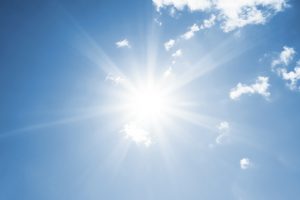 The Department of Health and Human Services has designated July as UV Safety Awareness month. According to the Center for Disease Control (CDC), “Less than half of older adults protect their skin from the sun when outside for an hour or more on a warm, sunny day. This may raise their risk of getting skin cancer.” Learning more about how being in the sun exposes skin to dangerous UV light and adopting better safety practices can help.
The Department of Health and Human Services has designated July as UV Safety Awareness month. According to the Center for Disease Control (CDC), “Less than half of older adults protect their skin from the sun when outside for an hour or more on a warm, sunny day. This may raise their risk of getting skin cancer.” Learning more about how being in the sun exposes skin to dangerous UV light and adopting better safety practices can help.
What is UV?
The sun’s energy reaches the earth in three different forms: visible, infrared, and ultraviolet (UV) rays. UV rays are invisible, electromagnetic energy that operates on a wave frequency. UV rays also come from other sources. Tanning booths, mercury vapor lighting, certain halogen, fluorescent and incandescent lights, and some types of lasers all emit UV rays.
UV and Your Skin
According to the U.S. Food and Drug Administration (FDA), there are two types of UV rays that affect the human body: UVB rays that have a short wavelength that reaches the outer layer of your skin (the epidermis), and UVA rays that have a longer wavelength that can penetrate the middle layer of your skin (the dermis). While a small amount of UV light can provide the body with Vitamin D, both types of UV rays are dangerous with prolonged exposure, and they trigger melanin in the body. The Johns Hopkins Medicine Health site explains in its article on Sun Safety that melanin is the first defense against the sun, absorbing UV rays: “A sunburn develops when the amount of UV damage exceeds the protection that the skin’s melanin can provide. A suntan represents the skin’s response to injury from the sun.” In addition to these short-term effects, long-term exposure to UV rays can lead to certain types of cancers, premature skin aging, cataracts, and other health complications.
Practice UV Safety
According to the American Academy of Dermatology (AAD), even one severe sunburn early in life “ can nearly double a person’s chance of developing melanoma, the deadliest form of skin cancer, later in life.” The effects of UV exposure are cumulative, so it is critical to continue to practice safety. In addition to avoiding tanning beds, there are some basic sun safety steps that everyone should take:
- Avoid being out in the sun between the hours of 10 a.m. and 2 p.m. when the UV rays are at their strongest.
- Wear protective clothing like long sleeves, long pants, a wide-brimmed hat and dark glasses.
- Use a water-resistant sunscreen with Sun Protection Factor (SPF) of 30 or more.
- Seek shade when appropriate.
- Use extra caution near water, snow, and sand since they reflect the UV rays.
- Protect your lips with lip balm with at least SPF 15.
- Get your Vitamin D from a healthy diet.
UV Safety and Older Adults
The AAD indicates that being 50 years or older increases your risk of developing melanoma. Other factors like a weakened immune system, having had other types of cancer, and taking certain medications increase the danger as well. The CDC notes that more than half of all cases of melanoma develop in people aged 65 or older. In its article, Many Older Adults Don’t Protect Their Skin From the Sun, the CDC revealed that nearly 18% of older adults don’t use any kind of sun protection regularly and even higher percentages only take partial measures to protect themselves. Given the higher risk to older adults, practicing UV safety is particularly important. The CDC recommends that communities help reduce the risk by providing shaded areas outside for older people to avoid direct sun exposure.
At Charles E. Smith Life Communities, our campus has many comfortable places outside to sit in the shade and enjoy the outdoors while practicing UV Safety. Call us at 301-770-8448 to find out about available move-in opportunities.
